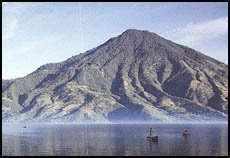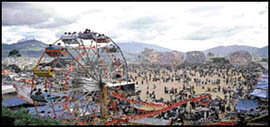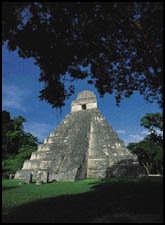 TOURISM TOURISM |
Guatemala is the best destination for those looking to live an unforgettable experience full of magic, color and adventure, and those who want to discover the traditions of a rich culture.

Guatemala is known by the hospitality of its people, the mysticism of its traditions, and the variety of ecosystems, volcanoes, flora and fauna. Its characterized as the Country of the Eternal Spring, even more if you experience an encounter with nature and discover the legacy of the Mayan Civilization in Peten's tropical jungle, where you find one of America's foremost archeological sites. Temples and palaces rise rise through the colored vegetation that covered them for centuries.
The variety of destinations allow you to sail across the magic Caribbean or to visit Antigua Guatemala, which preserves the architectural of a Spanish city and was declared by UNESCO as Heritage of Mankind for being one of the world's most magnificent colonial capitals
The hotel industry has the full market of standards that cater to every ones needs, whether it be back packing through the jungle, honeymooning or in the capital city for business. The hotels of Guatemala city are world class. Among the leaders are Marriot, Intercontinental, Quinta Real and the Westin Camino Real
And if you like adventure imagine yourself trekking trough tropical jungles, climbing volcanoes, and exploring mysterious caves. On the other hand, enjoy the thrill of water rafting, an arqueological diving excursion, or admire amazingly by UNESCO as Heritage of Mankind for being one of the world's most magnificent colonial beautiful birds sic architecture with the modern buildings in Guatemala City. The active and cosmopolitan city has all the first class accommodations and tourist facilities for any demanding visitor

The "shaft-less" industry is the main opportunity for the economic and social development of our country. Too many still do not grasp the dimension of the multiplier effect and great potential that tourism has as a formal economic activity, mainly for Guatemala. This idea comes from the "developmental" view of our structures through the traditional economists' prisms, that regard physical production (agriculture, industry, mining, commerce, livestock, etc.), as the only possible means of development, without taking into consideration the options offered by the service industry, and most significantly, tourism. Tourism, aside from being a strong impulse for development, is a sufficiently flexible industry, which adapts the way it produces and manages, to the changing circumstances of the market and what society demands.
This activity is becoming more important due to the incidence it has in the social, cultural, economic and political arenas. In Guatemala, the "shaft less" industry started becoming important in 1967, when the Guatemalan Institute of Tourism was created. Later, in 1974, the "Ley de Fomento Turístico Nacional" (National Tourism Promotion Law), was approved; nonetheless, it expired a few years ago.
It is during the 70s that tourism achieves an important growth in the country, becoming the second income generator of foreign exchange. However, due to the internal problems of the country, a considerable decrease occurs during the 80s. This situation began a slow but sustained recuperation process in 1985, when general elections were summoned and the democratic process was reestablished.
Currently, tourism continues to be the second economic force in the country. In 1999 it produced foreign exchange income of US$ 399 million. Nevertheless, a real take-off has not been achieved in this sector due to lack of infrastructure in important areas of tourist attraction, scarce entrepreneurial development of new products, the security issue, and that the promotion of Guatemala as a tourist destination has not been adequate. Tourism as an Instrument of Development The "shaft-less" industry has become a necessary foundation for the growth and development of other productive areas. Of the final production, the one directly dedicated to consumption - tourism -- requires numerous goods and services. This unique trait allows for the benefits of tourism expense to be broadly distributed among the different productive areas. | 
It should also be considered that a good portion of tourist dollars are spent through the informal sectors such as handicrafts and markets (Chichicastenango, Panajachel and Antigua are a clear example), which are not officially accounted for, but represent the "modus vivendi" of families and entire communities.
 A Joint Effort A Joint Effort |
Countries like Costa Rica and Mexico, our main competitors in the region, have been able to place tourism as the main generator of foreign exchange income, since government and private enterprise regard the tourism industry as a national priority, promoting and facilitating the development of infrastructure projects, training and decentralization of the promotional activities.
Tourism promotion has been traditionally a responsibility of the public administration, in this case, of INGUAT. The actual trend is to channel more economic resources and qualitatively improve the use of available resources, through mixed entities in which the private and public sectors participate, not only in obtaining and generating economic resources, but also in planning and deciding the destiny of such funds.

Government has to shift from being a controller to a second stage, becoming a promoter and finally as a coordinator, basing its activities on the following parameters:
1. Liberalize the regulation of economic activities. Flexibility of basic regulations.
2. Increase participation and control of the private sector in promotion and tourism incentive policies.
3. Environmental and Consumer Protection:
Technical security and environmental protection requirements, mainly in the regulation of the tourist use of protected areas. Quality of services offered, mainly regarding accommodations and food. Main Tourism Indicators. The importance of tourism within the economy lies in the generation of foreign currency, a source of employment (direct and indirect), and investment in infrastructure. Additionally, for each visitor to the country, the government collects income through taxes. Some of these are direct taxes: the Airline Ticket Tax (10%), the Hotel Tax (10%) and the Airport Departure Tax (US$20.00 per person).

Empirically, estimating that in 1998 Guatemala received 636,276 visitors, of which 257,588 (52.1%) arrived by air, they must have paid a total of US$ 5,151,760 in Airport Departure Taxes. Likewise, if the country offers 14,744 hotel rooms, and according to INGUAT's statistics, in 1998 had a 57% occupancy rate (8,404 rooms), at an average rate of US$ 50.00, Hotel Tax amounted to US$ 42,020.00 and the same for Value Added Tax (IVA). This is US$ 84,040 per day.
Likewise, according to the Dirección General de Migración (Immigration Department), a total of 249,409 Guatemalans traveled abroad by air during 1998. If we estimate an average price of US$ 300.00 per ticket, this means that both the Airline Ticket Tax and the IVA generated an estimated total of US$ 14,964,540.00 for the year. All of these, in conjunction with the generation of approximately 70,000 direct jobs and an estimated 350,000 indirect jobs, in addition to the corresponding foreign exchange income. |

